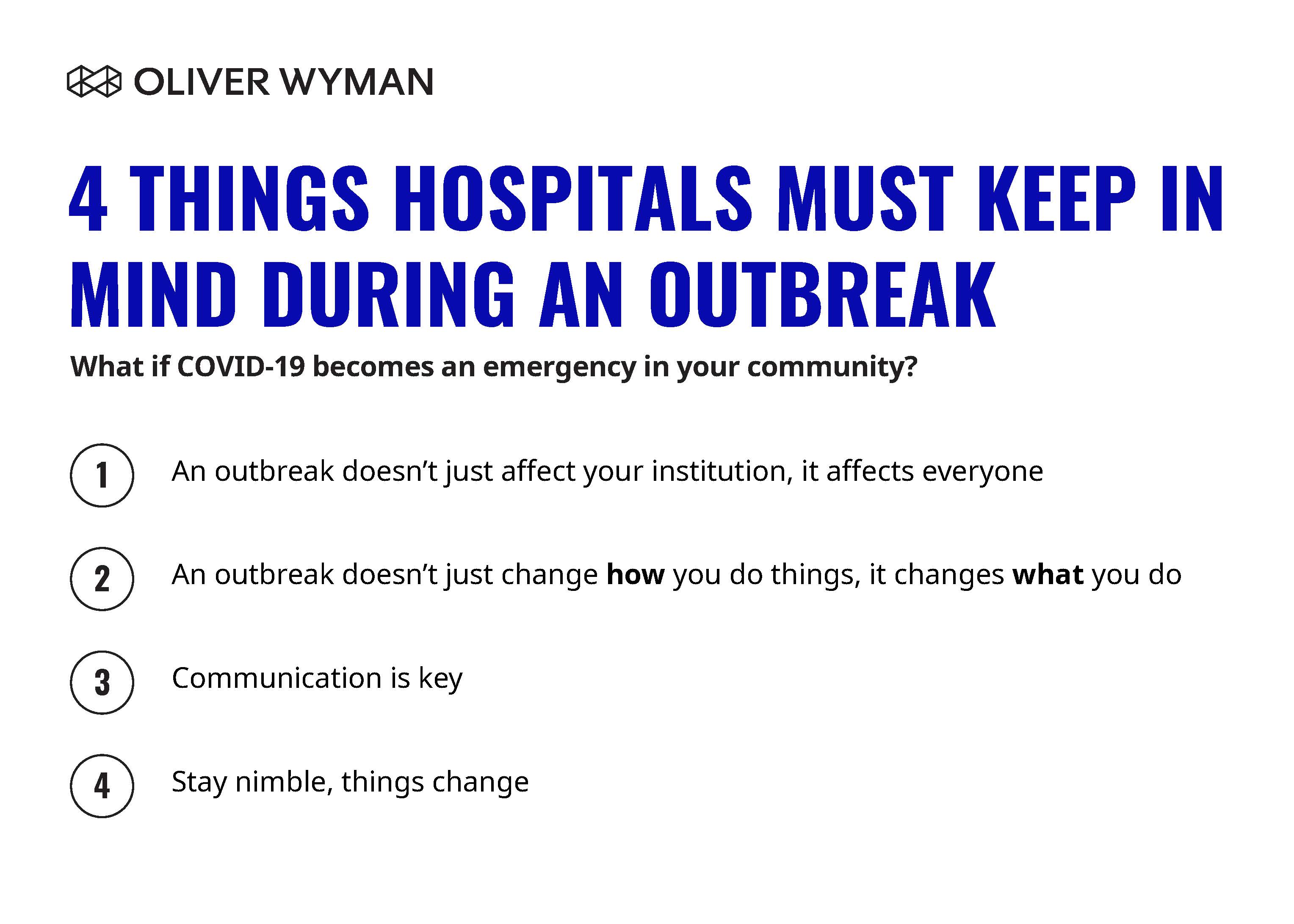Editor’s Note: The following article is part of an ongoing series offering our strategic advice and expertise on what hospitals, healthcare workers, providers, and caregivers should do immediately in response to the rapidly evolving novel coronavirus (COVID-19) pandemic. What follows are strategies and tactics that we hope will help hospitals and health systems prepare for and contend with the coronavirus pandemic.
If COVID-19 becomes a full-fledged emergency in your community, are you ready to respond? For hospitals – especially those serving smaller communities and rural areas – the answer depends on how thoroughly you’ve planned for a severe outbreak’s potential effect on your institution. We’ve written before about a key challenge for medical practices so far: shortages of labor capacity and supplies. Although those are good starting points, a robust emergency plan must go much further.
An outbreak doesn’t just change how you do things. It changes what you do.
If an outbreak strikes, you probably won’t be delivering your usual services. Elective procedures, well-patient visits, tests, and so forth will likely be canceled, both because sick staff will leave you too shorthanded and because patient safety will demand it. Instead, you will revert to a role US hospitals haven’t played for several generations: concentrating resources on infectious diseases. This has multiple implications:
A large outbreak produces a surge of patients in need of treatment. Data indicates that about 20 percent people who become sick with COVID-19 require hospitalization.
A key challenge in preparing is figuring out how to prevent patients who may have COVID-19 from coming to the hospital or clinic at all. Communication about indications for visit and providing access to advice through electronic means, by telemedicine or a call center, could be a great help. Move visits to video and phone lines when appropriate.
You will need a plan for sorting the symptomatic and potentially infected into one group who can safely weather and monitor the disease at home and another more severely ill group who requires admission.
More questions:
- Who will provide COVID-19 testing? Will it be free or is there a charge? How quickly will results be available and who will follow up on positives? What is the plan for contact tracing and quarantine of close contacts? Will people being screened need to enroll as patients of the health system or in a public health database? All these issues need discussion and planning before the event occurs.
- A number of those patients who could be released to home monitoring may not have an adequate support system. These may include single people, the homeless, and others. Some provision for non-hospital care to provide food, sanitary facilities, and monitoring for illness progression will be needed. Consultation with public health and local officials should be held in advance to plan for this.
- A major community outbreak could easily fill more beds at a typical facility than were designed to accommodate patients with infectious diseases, filling intensive care unit capacity to the point of overflow with ventilator-dependent patients. There must be a plan to reassign space, train staff on procedures, and maintain isolation. None of this should be done on the fly once an outbreak has already begun.
- Your plans for handling patients from residential facilities and nursing homes must specify which facilities can safely care for the clinically ill and whether they can accept patients from your facility who require their care.
Constant public communication between the health system, the department of health, and city, county, or state officials is key to alleviating public and staff apprehension and forestalling panic. Since there will be inevitable changes in response as the outbreak proceeds, the message will change. Your hospital already has a public health system spokesperson, someone who tracks The Centers for Disease and Control Prevention’s (CDC) statements and recommendations religiously: your infectious disease control officer. Ensure this person is credible on COVID-19 and able to answer difficult questions in real-time as they emerge.
Infectious disease outbreaks are dynamic. Regarding previous outbreaks of Toxic Shock Syndrome, HIV-AIDS, and the coronaviruses causing SARS and MERS, each presented new challenges as they progressed. It is highly likely as the COVID-19 outbreak develops, it will follow that pattern.
Here are some key topics and questions for you and your team to consider.
An outbreak doesn’t just affect your institution. It affects everyone else’s, too.
Outbreaks don’t just make patients (and healthcare providers) sick; those patients are also workers who maintain vital community services – like the police, firefighters, and ambulance drivers. You have probably considered these kinds of issues before when planning for location-specific emergencies like earthquakes or floods. Indeed, a severe pandemic has many of the same effects.
1. Consider how short-term, unexpected problems that may have once been mere inconveniences may now lead to larger emergencies. As you prepare for COVID-19, it’s possible that other simultaneous disasters may arrive in pairs or trios. If, for example, a storm comes and takes out power lines, that’s one thing. But if a storm takes out power lines when the local electric company’s workforce is understaffed by 20 percent, your institution could now be without power for days. Do you have the generator capacity and the fuel to keep operating?
2. Consider where your resources are sourced from. Many hospitals have invested considerable effort into providing patients with healthier meals, including fresh fruits and vegetables. But an outbreak can hinder the workers who harvest, package, and transport produce, for instance, making that sort of food difficult or impossible to source. The problem could be especially severe if Mexico and Latin America – major sources of produce for the US – lose production capacity. Or, if the US government bans travel and products from the area as a safety measure. If any of these scenarios occur, hospitals must rethink their vendors and completely change both their menus and their approach to feeding patients.
3. Consider the police may be unavailable or badly stretched. In outbreaks, emergency departments may become packed beyond capacity. As a result, doctors may not be immediately available to see patients. In times of crisis, it’s not unusual for hostile, sometimes violent, behavior to emerge. Crowd control during moments like these is crucial. If your normal procedure involves calling the police, think twice. The reason is, during an outbreak, police may also be short-staffed due to illness. They may, for instance, be pulled to only perform critical duties, like guarding state prison inmates when the assigned guards themselves become ill, or assisting with life-or-death situations only, like major traffic accidents. Therefore, anticipate slower responses to calls for help in the emergency department. Hospitals’ onsite security services must be prepared to back up police as needed. This could involve additional training and some arrangement with local law enforcement officials. Consider also that your security staff may need to be officially deputized to take on fuller police authority.
4. Consider specifically topping up your gas and oxygen supplies. When planning for drug shortages, medical gases are often overlooked. If a COVID-19 outbreak is likely to be declared for your area, topping up your supplies is advisable. This is because the lack of truck drivers, or pressure to supply other, higher acuity facilities, may limit your access. Since COVID-19 is a respiratory disease, oxygen usage will almost certainly increase.
Further developments in our understanding of the spread, prevention, and potential treatment of COVID-19 and its impacts on the many sectors of the economy will follow.


